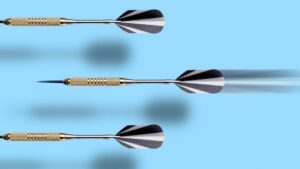Barry FitzGerald: Two explorers who can take a slice of China’s ionic pie

‘Garimpeiro’ columnist Barry FitzGerald has covered the resources industry for +35 years.
Rare earth stocks have perked up since China said it would restrict exports of gallium and germanium used in computer chips in retaliation for US bans and restrictions on the sale to the country of chip dependent high-end technologies.
Gallium and germanium are not rare earths. But like rare earths the supply of the obscure metals is currently controlled by China, leaving pundits to wonder if China could turn to limiting rare earth supplies next.
China has been there before with rare earths, famously slashing export quotas back in 2010. The US, Europe and Japan freaked and rare earth prices skyrocketed. Calm was returned after China was taken to the World Trade Organisation.
But the seeds of doubt were sown. If it is good enough for gallium and germanium to be used in Beijing’s tit-for-tat with the White House, maybe rare earths could be next with 2010 type consequences.
The next setting of the export quota is in September. There is no panic yet that rare earths could be next, with prices for the key magnet rare earths – crucial to electric vehicles and wind turbines – continuing to bounce along at levels about half of what they were a year ago.
There is currently surplus supply in China and capacity utilisation is about 75%.
So prices won’t be shooting higher anytime time soon unless the trend of increasing exporting quotas is reversed for the first time in a long time at the September setting – either in retaliation against the US, or simply to improve Chinese margins.
The longer-term outlook for rare earths is more certain, with a tipping point expected to emerge in coming years where supply from China and the rest of the world will fall hopelessly short of demand.
There is an almighty push by governments around the world to close that looming supply gap while at the same time reducing the Western world’s current high dependency on China across rare earth oxides, metal and magnets.
It is a huge undertaking, with Goldman Sachs recently estimating a cost of $US15-$US30 billion to establish a 50,000tpa ex-China market involving mines, refineries, metal production and magnet processing capacity.
No wonder then that apart from Lynas (ASX:LYC), the biggest producer outside of China and getting bigger still, there is a long list of rare earths players on the ASX in Garimpeiro’s patch of explorers/developers.
This week’s particular interest is in the rise of the ionic clay-hosted rare earths explorers as distinct from the hard-rock players. The ionic types stand as a disruptive force in the rare earths scene because they are taking on the Chinese at their own game.
Chinese dominance of the global industry is built on low-cost and low-capex ionic clay deposits in southern China and Myanmar. But clay deposits with ionic features are not the preserve of the Chinese.
And as it is, a bunch of ASX companies have been notching up major exploration success with ionic-type discoveries. Not only are they of a scale and grade capable of giving the Chinese a run for their money, they answer the call for more non-China supplies, and in a hurry.
There are some familiar and not-so familiar names amongst them. Garimpeiro can’t list them all today so has settled on two that demonstrate that as part of the broader rare earths space on the ASX, just how dynamic the ionic clay subset has become.
METEORIC (ASX:MEI): This one needs no introduction for Stockheads. It’s the one that picked up a clay deposit in Brazil in December that Japan’s body in charge of securing that nation’s mineral and energy needs had previously confirmed as being of the ionic type.
It was 1.5c at the time. It was trading mid-week at 26.5c, making it an 18-bagger.
Although its market cap now stands at $510m in response to its release of a world-scale maiden resource estimate of 409 million tonnes grading an impressive 2,626ppm, analysts reckon there is more to come.
Sprott’s equity desk has a 50c price target on the stock for a market cap of more than $1 billion on a fully diluted basis. “It is our pick for best rare earth project globally.’’
Euroz Hartleys has just initiated coverage on the stock with a 36c price target. It said the stock represents “standout exposure’’ to ionic clays thanks to the grade of the resource exceeding the average of its Western peers by 2.3 times, among other things.
DEVEX (ASX:DEV): It’s from the Tim Goyder stable of Liontown and Chalice fame. Could it be that Goyder – a 17% shareholder and chairman – could be on to repeating his lithium (Liontown) and nickel-copper-PGE (Chalice) success in ionic clay rare earths?
It’s early days but there is no doubting that DevEx’s Kennedy project in north Queensland could be something special. Initial testwork confirmed Kennedy is of the ionic type and first drilling has returned high grade results starting from surface.
But more to the point is the sheer scale of the thing.
The targeted clays are extensive and if there is continuity in the mineralisation encountered in the wide-spaced drilling to date, and in future step-out drilling to the horizon and beyond in the flat-lying country, the potential is for hundreds of millions of tonnes of resource, if not a billion.
It is only potential at this stage but it’s one to watch. The market cap is $108 million which until the May disclosure of the Kennedy discovery, was more or less covered by the company’s cash of $15 million and its high-grade uranium hunt at Nabarlek in the Northern Territory.
That’s another reason to keep an eye on the stock as drilling is underway at Nabarlek, with results to come down the pipeline before long.
The views, information, or opinions expressed in the interviews in this article are solely those of the interviewees and do not represent the views of Stockhead. Stockhead does not provide, endorse or otherwise assume responsibility for any financial product advice contained in this article.
Related Topics

UNLOCK INSIGHTS
Discover the untold stories of emerging ASX stocks.
Daily news and expert analysis, it's free to subscribe.
By proceeding, you confirm you understand that we handle personal information in accordance with our Privacy Policy.








